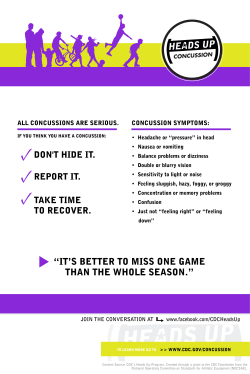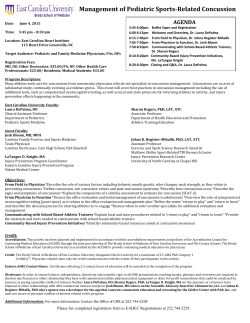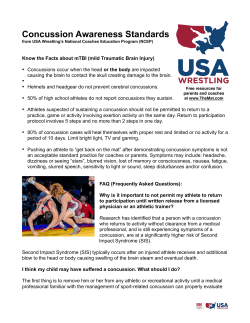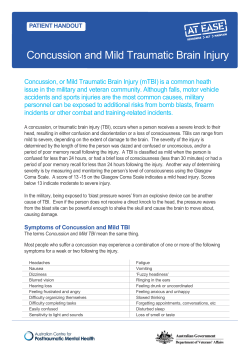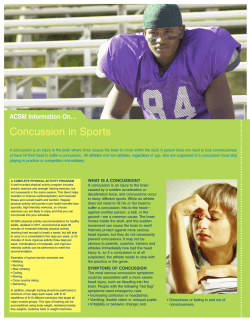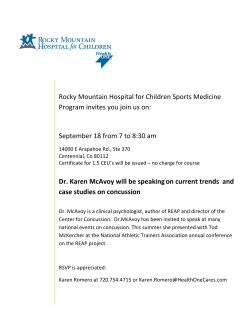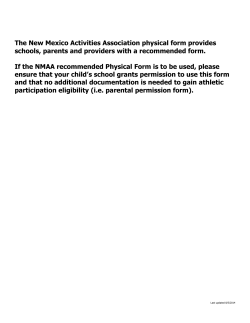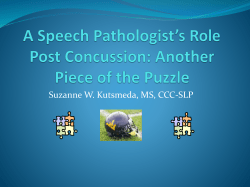
What We Know and Don’t Know About Multiple Concussions
What We Know and Don’t Know About Multiple Concussions Source: Produced by Vicky Youcha and Brian King Video Link: http://www.brainline.org/content/multimedia.php?id=3508 Dr. Jeffrey Barth: There is a growing literature concerning exposure to concussive and subconcussive blows and understand much of our science to this point is not anywhere near complete. We have anywhere from case studies to some controlled studies to look at these issues but there are many people in the field who have done excellent work in this area. One is Dr. Kevin Guskiewicz at University of North Carolina who has studied exposure and how many times people get these concussions and the way they've done that is using some actually some new helmet technology. They've applied the Simbex System that's now owned by Riddell, the helmet manufacturer and in some helmets you can put sensors which can pick up the acceleration deceleration forces and it uses a technology to get that information to the sideline while the person is playing and so you can tell how hard the hit is and how often people are hit. It certainly makes a difference as to how hard you're hit but we do find people that get over 100 G's of acceleration in a hit and are perfectly normal, have not had a problem at all and they record them up to about 120 G's actually of acceleration force. Yet you may have somebody who has a 40 G hit and they have some problems so it's, there's not a one-toone correlation in terms of the severity of the hit as to whether you're really going to have a concussion or not. There's also an individual vulnerability factor. Everybody is different and so for everybody experiences concussions differently. Some people have a severe problem with it. Some people don't and the key to figuring out when someone can go back to play is to evaluate the things I talked about earlier but it's also to take the individual into account and one of the things that is really critical in understanding how significant this problem could be is how many actual concussions a person has had and how many exposures they've had. Dr. Guskiewicz found that in a particular, in a typical season, that there are pretty close to 1,000 hits. These would be with probably in the college ranks and the professional ranks. So that's a lot of potential concussions or even sub-concussive blows where there's shaking but you wouldn't consider it a concussion. So it's important to know how many times a person's been exposed if you can and that's something that's very difficult to get a handle on but what you can know about is how many concussions they've had in the past and that brings us really to the topic of when have you had too many concussions and we just do not know the answer to that problem. The only way you could possibly know it is to expose people after they've had two or three or four or five concussions, keep exposing them and see when it is that they start to lose things. Well of course we can't do that so exposure is a pretty important thing. I'm often asked should my child stop playing. This is their third concussion for example. I would want to know a lot of things. What were those concussions like? How severe were they? What were the symptoms associated with them and when did they happen? If they had a concussion in the ninth grade, one in their senior year of high school and then one their freshman year of college, that's a very different scenario to someone who has had three concussions in the Page: 1 of 2 same season and part of this medicine is actually art. We are not entirely sure. I'm also going to want to know how much it took for that person to have their third concussion because we know once you've had one concussion, you are three to six times more likely to have a second concussion and we also know by case study that the more concussions you get, the easier it is to get them, the less of an impact or the less acceleration you have to have in order to actually experience a concussion. Had a soccer player that had had multiple concussions, a woman and her last concussion before we retired her from play she had just been grazed by a knee. Her head had been grazed by a knee and she had symptoms immediately came back. So again, you need to treat the individual as that, an individual. You have to look at their individual history. How vulnerable are they? There's also a study from some years back that implicates multiple concussions have a more significant effect with children with learning disabilities or attention deficit disorder. This was a study I believe it was in the New England Journal of Medicine and so this just speaks further to the individual vulnerability issue. I want to know a lot about that person before I say they can go back to play. Of course the best thing to do is be conservative. We don't want to dumb down America by having them have multiple concussions and not really, to steal a phrase, be all that you can be. When I'm talking with concerned parents and students, I do ask them are you comfortable with the idea that this might impair your ability to think well enough to do well on those SAT's and get to college and do the things that you want to do. How important is this to you? Page: 2 of 2
© Copyright 2025
